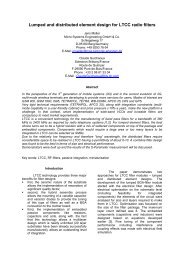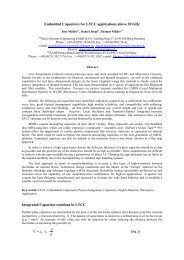View - Micro Systems Engineering
View - Micro Systems Engineering
View - Micro Systems Engineering
You also want an ePaper? Increase the reach of your titles
YUMPU automatically turns print PDFs into web optimized ePapers that Google loves.
film alumina have a better performance regarding<br />
thermal conductivity (λ ≈ 24 W/m*K). Their weakness<br />
is, however, the hermeticity of vias through the<br />
substrate.<br />
Thermal vias in LTCC are able to improve<br />
the integral value of the thermal conductivity.<br />
Depending on the array formation (diameter of vias<br />
and pitch), values comparable to alumina or even<br />
better can be achieved [1][2].<br />
Fig. 1 shows the build-up structure of a<br />
MMIC-package mounted on a FR-4 board with<br />
thermal vias and an embedded metal core. Thermal<br />
vias in the LTCC conduct the heat to the package<br />
heatsink which act as a heat spreader. The latter is<br />
glued or soldered to the copper pad on the FR-4. It<br />
should be mentioned that the bonding methods for<br />
die, heat sink and package is important for the<br />
thermal management as well [3].<br />
Fig. 1: Build-up structure for a MMIC in a LTCC package assembled on a FR-4 board with metal core<br />
Hermeticity Test Coupon Design and Procedure<br />
Since hermeticity is a required function of<br />
the package, the thermal options need to be evaluated<br />
in more detail. The material system selected was<br />
DuPont 951AX. Due to the space application<br />
requirements, the Au conductor system was selected<br />
for the test. Vias in LTCC have a high metal content<br />
(for good conductivity) and a very low glass content<br />
as bonding agent. Therefore, bonding to the glassceramic<br />
walls is not fully achieved. Increasing the via<br />
diameter (typical for thermal vias) increases the risk<br />
for a potential leakage. For a single layer with thermal<br />
vias it is doubtful whether full hermeticity can be<br />
realized.<br />
In the study, six different design cases were<br />
considered (Fig. 2). Packages might be required with<br />
(case a and d) or without heat spreader attached. The<br />
other options are two versus four layer designs and<br />
thermal vias with or without diameter variation<br />
between layers.<br />
Fig. 2: Design options considered for the<br />
hermeticity test pattern<br />
The via diameter used are 250 µm and<br />
130 µm after firing. Furthermore, two ways of<br />
feeding signals into the package were considered.<br />
Fig. 3 shows a schematic cross section with RF<br />
feeding lines from package pads to the inner cavity.<br />
The cavity wall is used for the cover assembly which<br />
can be realized by a metal lid, kovar frame + lid,<br />
metal cover or metallized plastic cover. The reasons<br />
to investigate the two configurations were to verify<br />
the hermeticity (leakage across the line type b) as<br />
well as the electrical performance.







